Forecasting of Built-Up Land Expansion in a Desert Urban Environment
Abstract
:1. Introduction
- What is the nature of desert urban dynamics across cities and towns in Oman?
- What are the dominant drivers of LULC across the desert urban environments of Oman?
- What are the magnitude and directions of LULC changes across desert urban areas? To what extent do these urban dynamics affect green cover?
2. Materials and Methods
2.1. Study Area
2.2. Data Acquisition and Processing
2.2.1. Satellite Imagery
2.2.2. LULC Classification and Accuracy
2.2.3. Multilayer Perceptron (MLP)
2.2.4. Markov Chain (MC)
2.2.5. Spatial Trends
3. Results
3.1. Model Validation
3.2. Driving Forces of Urban Dynamics
3.3. LULC Probability Transitions
3.4. MLP Simulation of Transition Potential Changes
3.5. LULC Change Analysis
3.6. Prediction of LULC Dynamics
3.7. Spatial Trends of LULC Changes
4. Discussion
5. Conclusions
Author Contributions
Funding
Conflicts of Interest
References
- UN. World Urbanization Prospects: The 2018 Revision. 2018. Available online: https://population.un.org/wup/Publications/Files/WUP2018-Report.pdf (accessed on 25 June 2021).
- UN. United Nation Decade for Desert and Fight against Desertification. 2021. Available online: https://www.un.org/en/events/desertification_decade/whynow.shtml (accessed on 24 June 2021).
- Nassar, A.K.; Blackburn, G.A.; Whyatt, J.D. Developing the desert: The pace and process of urban growth in Dubai. Comput. Environ. Urban Syst. 2014, 45, 50–62. [Google Scholar] [CrossRef] [Green Version]
- Mansour, S.; Al-Belushi, M.; Al-Awadhi, T. Monitoring land use and land cover changes in the mountainous cities of Oman using GIS and CA-Markov modelling techniques. Land Use Policy 2020, 91, 104414. [Google Scholar] [CrossRef]
- Andrade, R.; Larson, K.L.; Hondula, D.M.; Franklin, J. Social–spatial analyses of attitudes toward the desert in a Southwestern US city. Ann. Am. Assoc. Geogr. 2019, 109, 1845–1864. [Google Scholar]
- Jenerette, G.D.; Wu, J. Analysis and simulation of land-use change in the central Arizona–Phoenix region, USA. Landsc. Ecol. 2001, 16, 611–626. [Google Scholar] [CrossRef]
- Halmy, M.W.A.; Gessler, P.E.; Hicke, J.A.; Salem, B.B. Land use/land cover change detection and prediction in the north-western coastal desert of Egypt using Markov-CA. Appl. Geogr. 2015, 63, 101–112. [Google Scholar] [CrossRef]
- Hosseini, S.; Gholami, H.; Esmaeilpoor, Y. Assessment of land use and land cover change detection by using remote sensing and gis techniques in the coastal deserts, South of Iran. Int. Arch. Photogramm. Remote Sens. Spat. Inf. Sci. 2019, 42, 489–492. [Google Scholar] [CrossRef] [Green Version]
- Salem, M.; Tsurusaki, N.; Divigalpitiya, P. Land use/land cover change detection and urban sprawl in the peri-urban area of greater Cairo since the Egyptian revolution of 2011. J. Land Use Sci. 2020, 15, 592–606. [Google Scholar] [CrossRef]
- Ansari, A.; Golabi, M.H. Prediction of spatial land use changes based on LCM in a GIS environment for Desert Wetlands—A case study: Meighan Wetland, Iran. Int. Soil Water Conserv. Res. 2019, 7, 64–70. [Google Scholar] [CrossRef]
- Becerril-Pina, R.; Mastachi-Loza, C.A.; González-Sosa, E.; Díaz-Delgado, C.; Bâ, K.M. Assessing desertification risk in the semi-arid highlands of central Mexico. J. Arid. Environ. 2015, 120, 4–13. [Google Scholar] [CrossRef]
- Barbero-Sierra, C.; Marques, M.-J.; Ruíz-Pérez, M. The case of urban sprawl in Spain as an active and irreversible driving force for desertification. J. Arid. Environ. 2013, 90, 95–102. [Google Scholar] [CrossRef]
- Maconachie, R. Urban Growth and Land Degradation in Developing Cities: Change and Challenges in Kano Nigeria; Routledge: London, UK, 2016. [Google Scholar]
- Tripathy, P.; Kumar, A. Monitoring and modelling spatio-temporal urban growth of Delhi using Cellular Automata and geoinformatics. Cities 2019, 90, 52–63. [Google Scholar] [CrossRef]
- Liu, J.; Zhang, Z.; Xu, X.; Kuang, W.; Zhou, W.; Zhang, S.; Li, R.; Yan, C.; Yu, D.; Wu, S. Spatial patterns and driving forces of land use change in China during the early 21st century. J. Geogr. Sci. 2010, 20, 483–494. [Google Scholar] [CrossRef]
- Msofe, N.K.; Sheng, L.; Lyimo, J. Land use change trends and their driving forces in the Kilombero Valley Floodplain, Southeastern Tanzania. Sustainability 2019, 11, 505. [Google Scholar] [CrossRef] [Green Version]
- Yan, X.; Li, J.; Shao, Y.; Hu, Z.; Yang, Z.; Yin, S.; Cui, L. Driving forces of grassland vegetation changes in Chen Barag Banner, Inner Mongolia. GIScience Remote Sens. 2020, 57, 753–769. [Google Scholar] [CrossRef]
- Wu, Y.; Wu, Z.; Liu, X. Dynamic changes of net primary productivity and associated urban growth driving forces in Guangzhou City, China. Environ. Manag. 2020, 65, 758–773. [Google Scholar] [CrossRef]
- Comber, A.; Fisher, P.; Wadsworth, R. What is land cover? Environ. Plan. B Plan. Des. 2005, 32, 199–209. [Google Scholar] [CrossRef] [Green Version]
- Lambin, E.F.; Geist, H.J.; Lepers, E. Dynamics of land-use and land-cover change in tropical regions. Annu. Rev. Environ. Resour. 2003, 28, 205–241. [Google Scholar] [CrossRef] [Green Version]
- Atik, M.; Işikli, R.C.; Ortaçeşme, V.; Yildirim, E. Definition of landscape character areas and types in Side region, Antalya-Turkey with regard to land use planning. Land Use Policy 2015, 44, 90–100. [Google Scholar] [CrossRef]
- Ellis, E.; Pontius, R. Land-use and land-cover change. Encycl. Earth 2007, 1, 1–4. [Google Scholar]
- Jaeger, J.A.; Bertiller, R.; Schwick, C.; Kienast, F. Suitability criteria for measures of urban sprawl. Ecol. Indic. 2010, 10, 397–406. [Google Scholar] [CrossRef]
- Bhatta, B. Urban growth and sprawl. In Analysis of Urban Growth and Sprawl from Remote Sensing Data; Springer: Berlin/Heidelberg, Germany, 2010; pp. 1–16. [Google Scholar]
- Hennig, E.I.; Schwick, C.; Soukup, T.; Orlitová, E.; Kienast, F.; Jaeger, J.A. Multi-scale analysis of urban sprawl in Europe: Towards a European de-sprawling strategy. Land Use Policy 2015, 49, 483–498. [Google Scholar] [CrossRef] [Green Version]
- Oueslati, W.; Alvanides, S.; Garrod, G. Determinants of urban sprawl in European cities. Urban Stud. 2015, 52, 1594–1614. [Google Scholar] [CrossRef] [PubMed] [Green Version]
- Airoldi, L.; Turon, X.; Perkol-Finkel, S.; Rius, M. Corridors for aliens but not for natives: Effects of marine urban sprawl at a regional scale. Divers. Distrib. 2015, 21, 755–768. [Google Scholar] [CrossRef] [Green Version]
- Bae, C.-H.C. Urban Sprawl in Western Europe and the United States; Routledge: London, UK, 2017. [Google Scholar]
- Hamidi, S. Urban sprawl and the emergence of food deserts in the USA. Urban Stud. 2020, 57, 1660–1675. [Google Scholar] [CrossRef]
- Squires, G.D. Urban sprawl and the uneven development of metropolitan America. In Urban Sprawl: Causes, Consequences, and Policy Responses; Urban Institute: Washington DC, USA, 2002; pp. 1–22. [Google Scholar]
- Zhao, P. Sustainable urban expansion and transportation in a growing megacity: Consequences of urban sprawl for mobility on the urban fringe of Beijing. Habitat Int. 2010, 34, 236–243. [Google Scholar] [CrossRef]
- Habibi, S.; Asadi, N. Causes, results and methods of controlling urban sprawl. Procedia Eng. 2011, 21, 133–141. [Google Scholar] [CrossRef] [Green Version]
- Chen, D.; Lu, X.; Liu, X.; Wang, X. Measurement of the eco-environmental effects of urban sprawl: Theoretical mechanism and spatiotemporal differentiation. Ecol. Indic. 2019, 105, 6–15. [Google Scholar] [CrossRef]
- Harvey, R.O.; Clark, W.A. The nature and economics of urban sprawl. Land Econ. 1965, 41, 1–9. [Google Scholar] [CrossRef]
- Chin, N. Unearthing the Roots of Urban Sprawl: A Critical Analysis of Form, Function and Methodology; Centre for Advanced Spatial Analysis (UCL): London, UK, 2002. [Google Scholar]
- Batty, M. Polynucleated urban landscapes. Urban Stud. 2001, 38, 635–655. [Google Scholar] [CrossRef]
- Arbury, J. From Urban Sprawl to Compact City: An Analysis of Urban Growth Management in Auckland; Academia: San Francisco, CA, USA, 2005. [Google Scholar]
- Nagendra, H.; Sudhira, H.; Katti, M.; Schewenius, M. Sub-regional assessment of India: Effects of urbanization on land use, biodiversity and ecosystem services. In Urbanization, Biodiversity and Ecosystem Services: Challenges and Opportunities; Springer: Dordrecht, The Netherlands, 2013; pp. 65–74. [Google Scholar]
- Hosseini, S.A.; Shahraki, S.Z.; Farhudi, R.; Hosseini, S.M.; Salari, M.; Pourahmad, A. Effect of urban sprawl on a traditional water system (Qanat) in the City of Mashhad, NE Iran. Urban Water J. 2010, 7, 309–320. [Google Scholar] [CrossRef]
- Lang, R.E.; Simmons, P.A. Boomburbs”: The Emergence of Large, Fast-Growing Suburban Cities in the United States; Fannie Mae Foundation: Washington, DC, USA, 2001; Volume 14. [Google Scholar]
- Bagaeen, S. Brand Dubai: The instant city; or the instantly recognizable city. Int. Plan. Stud. 2007, 12, 173–197. [Google Scholar] [CrossRef]
- Díaz-Caravantes, R.E.; Zuniga-Teran, A.; Martín, F.; Bernabeu, M.; Stoker, P.; Scott, C. Urban water security: A comparative study of cities in the arid Americas. Environ. Urban. 2020, 32, 275–294. [Google Scholar] [CrossRef]
- Dewan, A.M.; Corner, R.J. The impact of land use and land cover changes on land surface temperature in a rapidly urbanizing megacity. In Proceedings of the 2012 IEEE International Geoscience and Remote Sensing Symposium, Munich, Germany, 22–27 July 2012 ; 2012; pp. 6337–6339. [Google Scholar]
- Brown, D.G.; Pijanowski, B.C.; Duh, J.D. Modeling the relationships between land use and land cover on private lands in the Upper Midwest, USA. J. Environ. Manag. 2000, 59, 247–263. [Google Scholar] [CrossRef] [Green Version]
- Brown, D.G.; Duh, J.-D. Spatial simulation for translating from land use to land cover. Int. J. Geogr. Inf. Sci. 2004, 18, 35–60. [Google Scholar] [CrossRef]
- Verburg, P.H.; Overmars, K.P. Combining top-down and bottom-up dynamics in land use modeling: Exploring the future of abandoned farmlands in Europe with the Dyna-CLUE model. Landsc. Ecol. 2009, 24, 1167–1181. [Google Scholar] [CrossRef]
- Singh, S.K.; Mustak, S.; Srivastava, P.K.; Szabó, S.; Islam, T. Predicting spatial and decadal LULC changes through cellular automata Markov chain models using earth observation datasets and geo-information. Environ. Processes 2015, 2, 61–78. [Google Scholar] [CrossRef] [Green Version]
- Qiang, Y.; Lam, N.S. Modeling land use and land cover changes in a vulnerable coastal region using artificial neural networks and cellular automata. Environ. Monit. Assess. 2015, 187, 57. [Google Scholar] [CrossRef]
- García-Álvarez, D. The influence of scale in LULC modeling. A comparison between two different LULC maps (SIOSE and CORINE). In Geomatic Approaches for Modeling Land Change Scenarios; Springer: Berlin/Heidelberg, Germany, 2018; pp. 187–213. [Google Scholar]
- Adbagher, E.; Becek, K.; Berberoglu, S. Modeling land use/land cover change using remote sensing and geographic information systems: Case study of the Seyhan Basin, Turkey. Environ. Monit. Assess. 2018, 190, 494. [Google Scholar] [CrossRef]
- Jiang, H.; Xu, X.; Guan, M.; Wang, L.; Huang, Y.; Liu, Y. Simulation of spatiotemporal land use changes for integrated model of socioeconomic and ecological processes in China. Sustainability 2019, 11, 3627. [Google Scholar] [CrossRef] [Green Version]
- Ren, Y.; Lü, Y.; Comber, A.; Fu, B.; Harris, P.; Wu, L. Spatially explicit simulation of land use/land cover changes: Current coverage and future prospects. Earth-Sci. Rev. 2019, 190, 398–415. [Google Scholar] [CrossRef]
- Liu, P.; Jia, S.; Han, R.; Liu, Y.; Lu, X.; Zhang, H. RS and GIS supported urban LULC and UHI change simulation and assessment. J. Sens. 2020, 2020, 5863164. [Google Scholar] [CrossRef]
- Talukdar, S.; Singha, P.; Mahato, S.; Pal, S.; Liou, Y.-A.; Rahman, A. Land-use land-cover classification by machine learning classifiers for satellite observations—A review. Remote Sens. 2020, 12, 1135. [Google Scholar] [CrossRef] [Green Version]
- Kafy, A.-A.; Shuvo, R.M.; Naim, M.N.H.; Sikdar, M.S.; Chowdhury, R.R.; Islam, M.A.; Sarker, M.H.S.; Khan, M.H.H.; Kona, M.A. Remote sensing approach to simulate the land use/land cover and seasonal land surface temperature change using machine learning algorithms in a fastest-growing megacity of Bangladesh. Remote Sens. Appl. Soc. Environ. 2021, 21, 100463. [Google Scholar] [CrossRef]
- Singh, V.K.; Kumar, V.; Jana, A. Spatial Distribution of Socioeconomic Factors and Its Impact on Urban Land Use Dynamics: An Agent Based Modeling Approach. In Urban Science and Engineering: Proceedings of ICUSE 2020; Springer: Singapore, 2021; Volume 121, p. 27. [Google Scholar]
- Rutherford, G.; Guisan, A.; Zimmermann, N. Evaluating sampling strategies and logistic regression methods for modelling complex land cover changes. J. Appl. Ecol. 2007, 44, 414–424. [Google Scholar] [CrossRef]
- Schubert, H.; Caballero Calvo, A.; Rauchecker, M.; Rojas-Zamora, O.; Brokamp, G.; Schütt, B. Assessment of Land Cover Changes in the Hinterland of Barranquilla (Colombia) Using Landsat Imagery and Logistic Regression. Land 2018, 7, 152. [Google Scholar] [CrossRef] [Green Version]
- Sekteria Pasaribu, U.; Virtriana, R.; Deliar, A.; Sumarto, I. Driving-factors identification of land-cover change in west java using binary logistic regression based on geospatial data. Proc. IOP Conf. Ser. Earth Environ. Sci. 2020, 500, 012003. [Google Scholar] [CrossRef]
- Clarke, K.C.; Hoppen, S.; Gaydos, L. A self-modifying cellular automaton model of historical urbanization in the San Francisco Bay area. Environ. Plan. B Plan. Des. 1997, 24, 247–261. [Google Scholar] [CrossRef] [Green Version]
- Nath, B.; Wang, Z.; Ge, Y.; Islam, K.; Singh, R.P.; Niu, Z. Land use and land cover change modeling and future potential landscape risk assessment using Markov-Ca model and analytical hierarchy process. ISPRS Int. J. Geo-Inf. 2020, 9, 134. [Google Scholar] [CrossRef] [Green Version]
- Hamedianfar, A.; Gibril, M.B.A.; Hosseinpoor, M.; Pellikka, P.K. Synergistic use of particle swarm optimization, artificial neural network, and extreme gradient boosting algorithms for urban LULC mapping from WorldView-3 images. Geocarto Int. 2020, 37, 1–19. [Google Scholar] [CrossRef]
- Handayanto, R.T.; Tripathi, N.K.; Kim, S.M. Land Use Growth Simulation and Optimization for Achieving a Sustainable Urban Form. Telkomnika 2018, 16, 2063–2072. [Google Scholar] [CrossRef]
- Parker, D.C.; Manson, S.M.; Janssen, M.A.; Hoffmann, M.J.; Deadman, P. Multi-agent systems for the simulation of land-use and land-cover change: A review. Ann. Assoc. Am. Geogr. 2003, 93, 314–337. [Google Scholar] [CrossRef] [Green Version]
- Al-Dhahra Spatial Strategy. 2020. Available online: https://www.aldahra.com/img/multimedia/Al-Dahra-Sustainability-Report-2020-V26.pdf (accessed on 20 April 2021).
- Abir, F.A.; Saha, R. Assessment of land surface temperature and land cover variability during winter: A spatio-temporal analysis of Pabna municipality in Bangladesh. Environ. Chall. 2021, 4, 100167. [Google Scholar] [CrossRef]
- Chemura, A.; Mutanga, O. Developing detailed age-specific thematic maps for coffee (Coffea arabica L.) in heterogeneous agricultural landscapes using random forests applied on Landsat 8 multispectral sensor. Geocarto Int. 2017, 32, 759–776. [Google Scholar] [CrossRef]
- Foody, G.M. Status of land cover classification accuracy assessment. Remote Sens. Environ. 2002, 80, 185–201. [Google Scholar] [CrossRef]
- Rwanga, S.S.; Ndambuki, J.M. Accuracy assessment of land use/land cover classification using remote sensing and GIS. Int. J. Geosci. 2017, 8, 611. [Google Scholar] [CrossRef] [Green Version]
- Pontius, R.G., Jr.; Millones, M. Death to Kappa: Birth of quantity disagreement and allocation disagreement for accuracy assessment. Int. J. Remote Sens. 2011, 32, 4407–4429. [Google Scholar] [CrossRef]
- Bratley, K.; Ghoneim, E. Modeling urban encroachment on the agricultural land of the eastern Nile Delta using remote sensing and a GIS-based Markov chain model. Land 2018, 7, 114. [Google Scholar] [CrossRef] [Green Version]
- Pijanowski, B.C.; Brown, D.G.; Shellito, B.A.; Manik, G.A. Using neural networks and GIS to forecast land use changes: A land transformation model. Comput. Environ. Urban Syst. 2002, 26, 553–575. [Google Scholar] [CrossRef]
- Shen, L.; Li, J.; Wheate, R.; Yin, J.; Paul, S. Multi-layer perceptron neural network and Markov chain based geospatial analysis of land use and land cover change. J. Environ. Inform. Lett. 2020, 3, 29–39. [Google Scholar] [CrossRef]
- Gustafson, E.J. Quantifying landscape spatial pattern: What is the state of the art? Ecosystems 1998, 1, 143–156. [Google Scholar] [CrossRef]

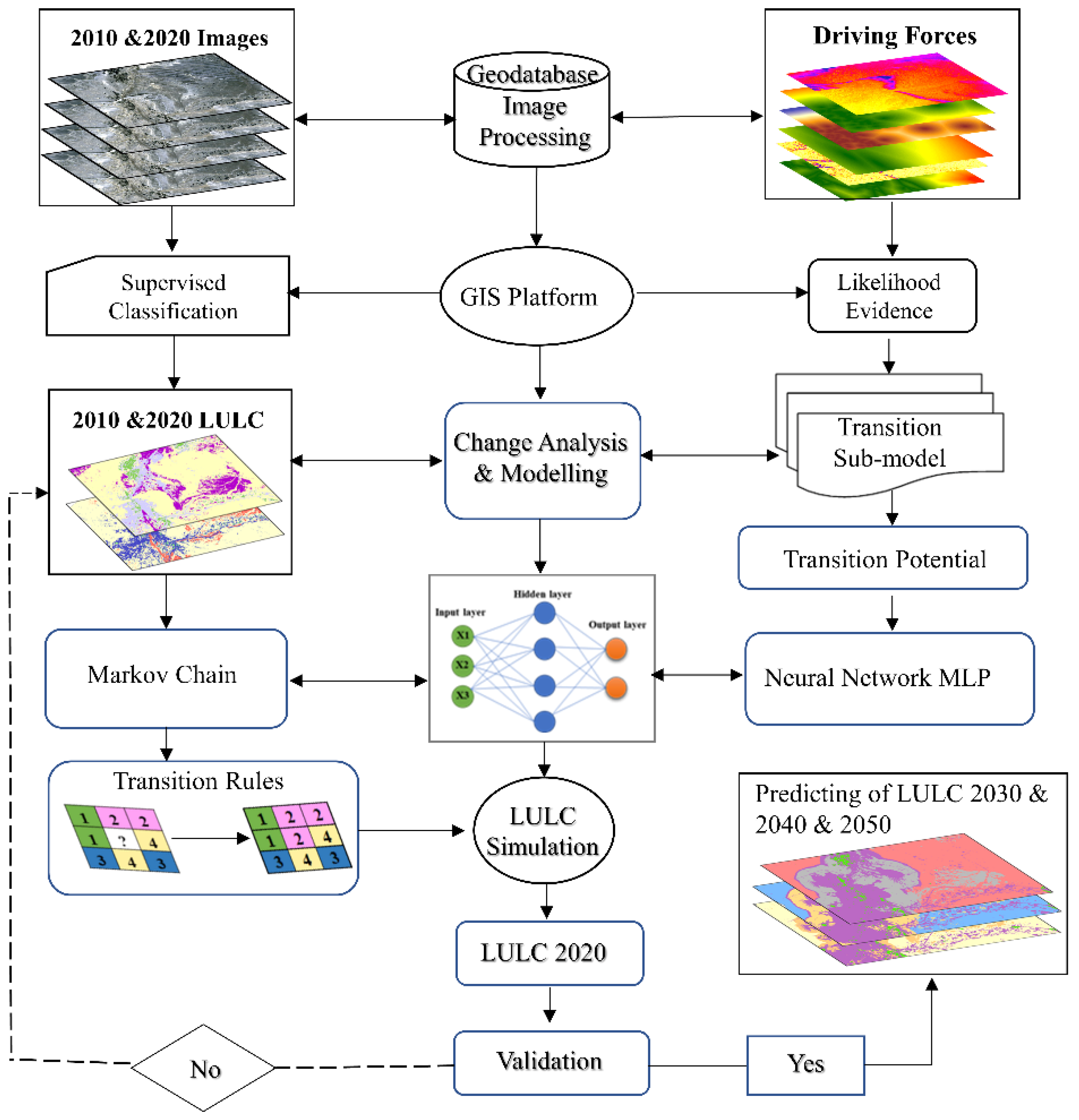
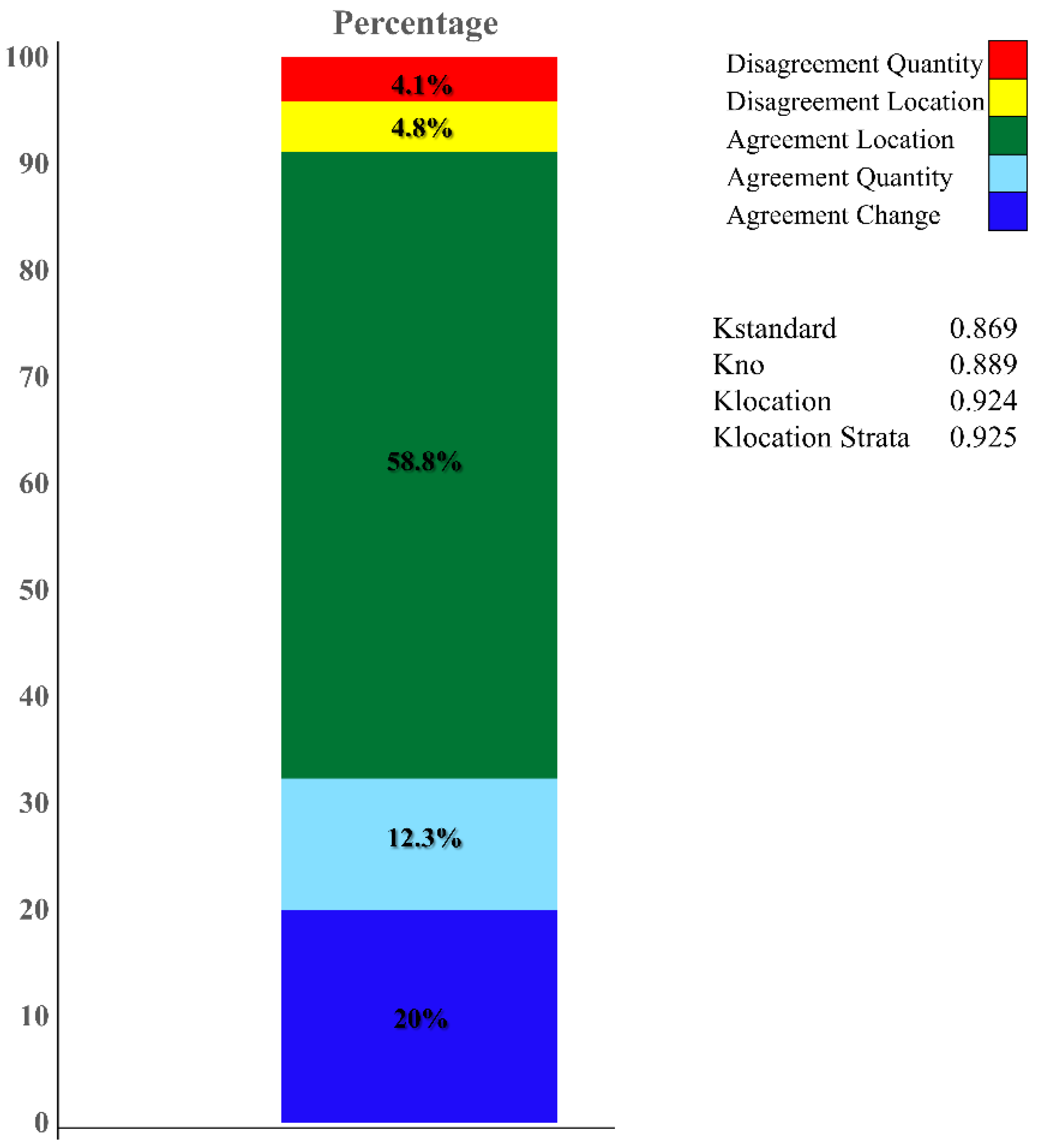
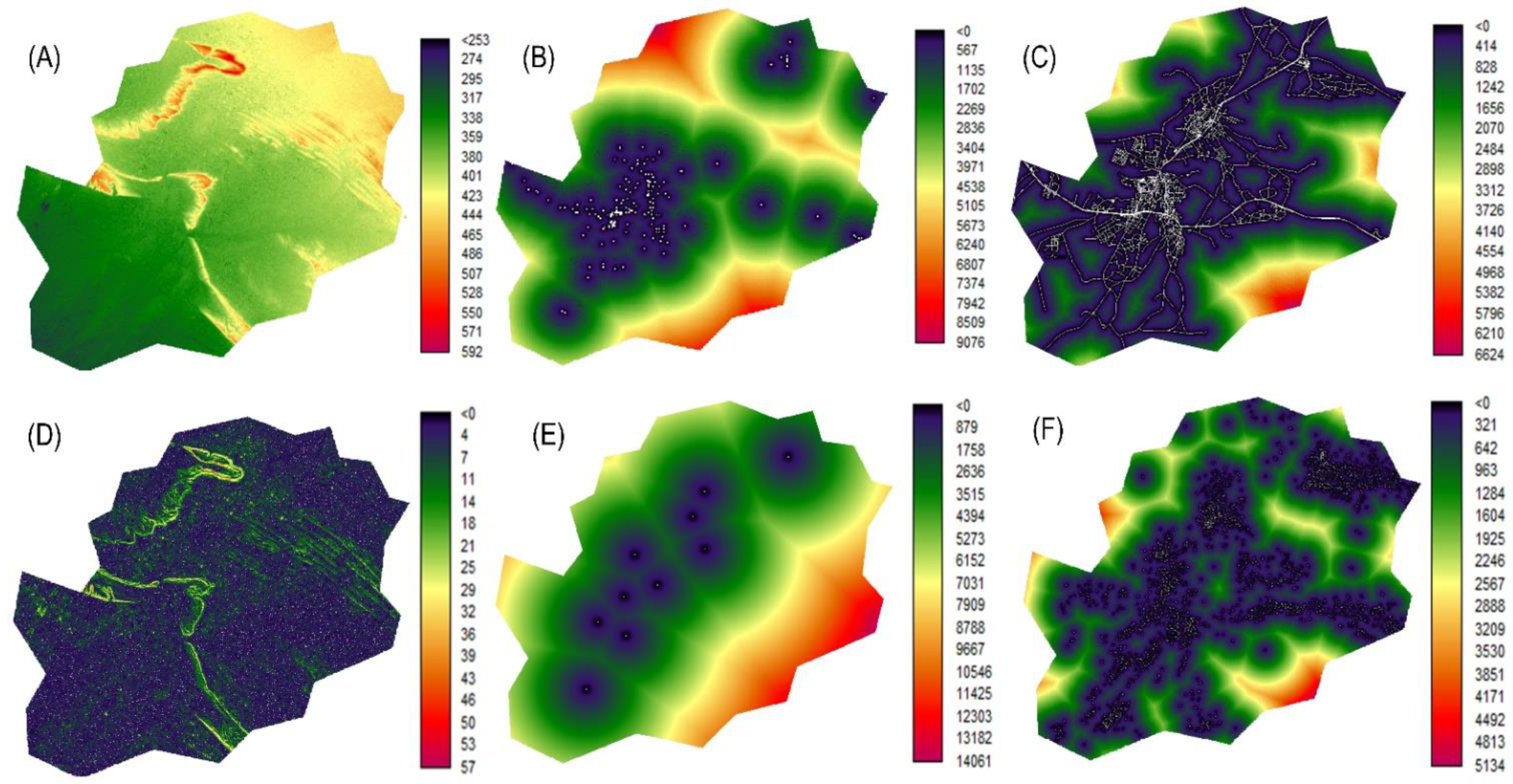
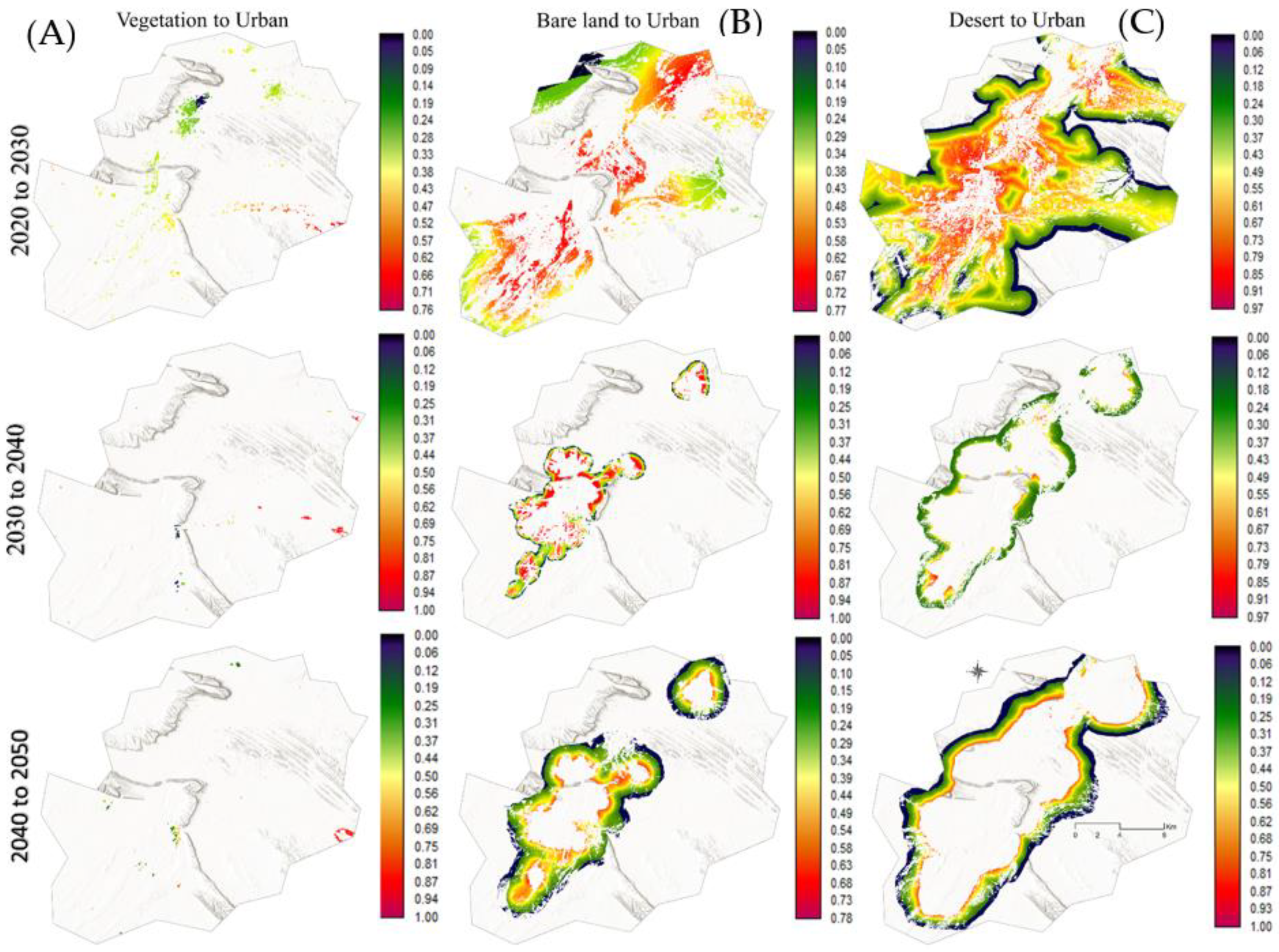
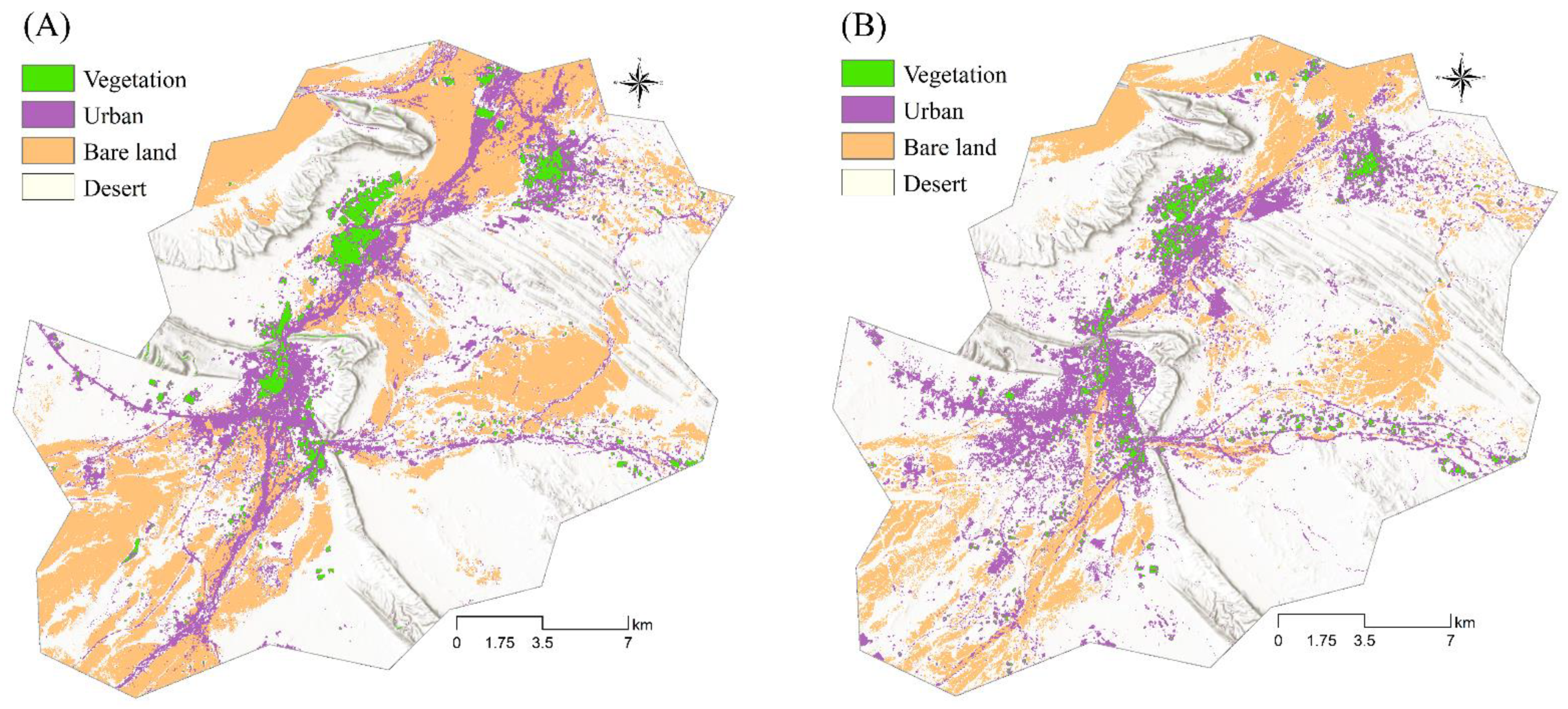

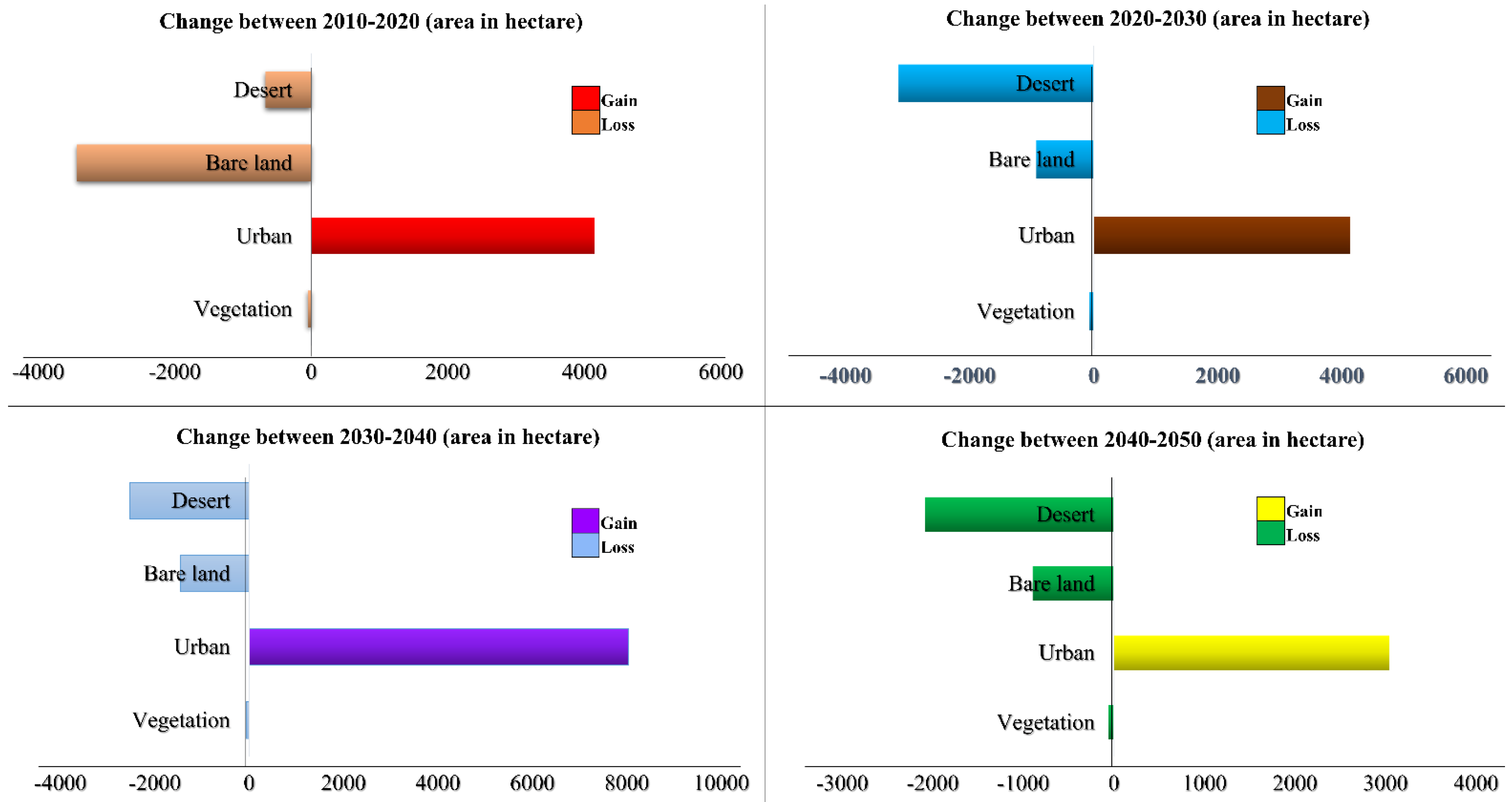

| Satellite/ Sensor | Spatial Resolution | Path/Raw | Date Acquired | Product Type | Cloud Cover |
|---|---|---|---|---|---|
| Landsat 7 ETM+ | 30 m | 159/044 | 21 January 2000 | L1TP | 0.00% |
| Landsat 7 ETM+ | 30 m | 159/044 | 17 February 2000 | L1TP | 0.00% |
| Landsat 8 OLI-TIRS | 30 m | 159/44 | 5 December 2000 | L1TP | 0.00% |
| Parameter | Outcome |
|---|---|
| Input layer neurons | 5 |
| Hidden layer neurons | 5 |
| Output layer neurons | 2 |
| Requested samples per class | 6418 |
| Final learning rate | 0.0005 |
| Momentum factor | 0.5 |
| Sigmoid constant | 1 |
| Acceptable RMS | 0.01 |
| Iterations | 10,000 |
| Training RMS | 0.2575 |
| Testing RMS | 0.254 |
| Accuracy rate | 93.67% |
| Skill measure | 0.873 |
| Model | Accuracy (%) | Skill Measure | Influence Order |
|---|---|---|---|
| With all variables | 93.67 | 0.8733 | N/A |
| Var. 1 constant | 93.48 | 0.8696 | 4 |
| Var. 2 constant | 79.47 | 0.5893 | 2 |
| Var. 3 constant | 93.42 | 0.8683 | 3 |
| Var. 4 constant | 93.65 | 0.8730 | 5 (least influential) |
| Var. 5 constant | 72.3 | 0.4460 | 1 (most influential) |
| Var. 6 constant | 81.4 | 0.8321 | 6 |
| Model | Variables Included | Accuracy (%) | Skill Measure |
|---|---|---|---|
| With all variables | All variables | 93.67 | 0.8733 |
| Step 1: var. [4] constant | [1,2,3,5,6] | 93.65 | 0.8731 |
| Step 2: var. [1,4] constant | [2,3,5,6] | 93.51 | 0.8702 |
| Step 3: var. [4,1,3] constant | [2,5,6] | 93.31 | 0.8661 |
| Step 4: var. [4,1,3,2] constant | [5,6] | 79.95 | 0.599 |
| Step 5: var. [4,1,3,2,5] constant | [6] | 86.33 | 0.644 |
| LULC Type | Area in 2010 (ha) | Area in 2020 (ha) | Change (2010–2020) |
|---|---|---|---|
| Vegetation | 1118.52 | 1068.48 | −50.04 |
| Urban | 6040.62 | 10,188.85 | 4148.23 |
| Bare land | 12,954.51 | 9525.06 | −3429.45 |
| Desert | 36,221.35 | 35,552.61 | −668.74 |
| LULC Type | Area in 2020 (ha) | Area in 2030 (ha) | Change (2020–2030) |
| Vegetation | 1068.48 | 1002.33 | −66.15 |
| Urban | 10,188.85 | 14,322.12 | 4133.27 |
| Bare land | 9525.06 | 8600.56 | −924.5 |
| Desert | 35,552.61 | 32409.99 | −3142.62 |
| Changes in LULC between 2030 and 2040 | |||
| LULC type | Area in 2030 (ha) | Area in 2040 (ha) | Change (2030–2040) |
| Vegetation | 1002.33 | 938.25 | −64.08 |
| Urban | 10,322.12 | 18,355.13 | 8033.01 |
| Bare land | 8600.56 | 7155.5 | −1445.06 |
| Desert | 32,409.99 | 29,886.12 | −2523.87 |
| Changes in LULC between 2040 and2050 | |||
| LULC type | Area in 2040 (ha) | Area in 2050 (ha) | Change (2020–2050) |
| Vegetation | 938.25 | 878.19 | −60.06 |
| Urban | 18,355.13 | 21,396.12 | 3040.99 |
| Bare land | 7155.5 | 6259 | −896.5 |
| Desert | 29,886.12 | 27,801.69 | −2084.43 |
Publisher’s Note: MDPI stays neutral with regard to jurisdictional claims in published maps and institutional affiliations. |
© 2022 by the authors. Licensee MDPI, Basel, Switzerland. This article is an open access article distributed under the terms and conditions of the Creative Commons Attribution (CC BY) license (https://creativecommons.org/licenses/by/4.0/).
Share and Cite
Mansour, S.; Alahmadi, M.; Atkinson, P.M.; Dewan, A. Forecasting of Built-Up Land Expansion in a Desert Urban Environment. Remote Sens. 2022, 14, 2037. https://doi.org/10.3390/rs14092037
Mansour S, Alahmadi M, Atkinson PM, Dewan A. Forecasting of Built-Up Land Expansion in a Desert Urban Environment. Remote Sensing. 2022; 14(9):2037. https://doi.org/10.3390/rs14092037
Chicago/Turabian StyleMansour, Shawky, Mohammed Alahmadi, Peter M. Atkinson, and Ashraf Dewan. 2022. "Forecasting of Built-Up Land Expansion in a Desert Urban Environment" Remote Sensing 14, no. 9: 2037. https://doi.org/10.3390/rs14092037
APA StyleMansour, S., Alahmadi, M., Atkinson, P. M., & Dewan, A. (2022). Forecasting of Built-Up Land Expansion in a Desert Urban Environment. Remote Sensing, 14(9), 2037. https://doi.org/10.3390/rs14092037








